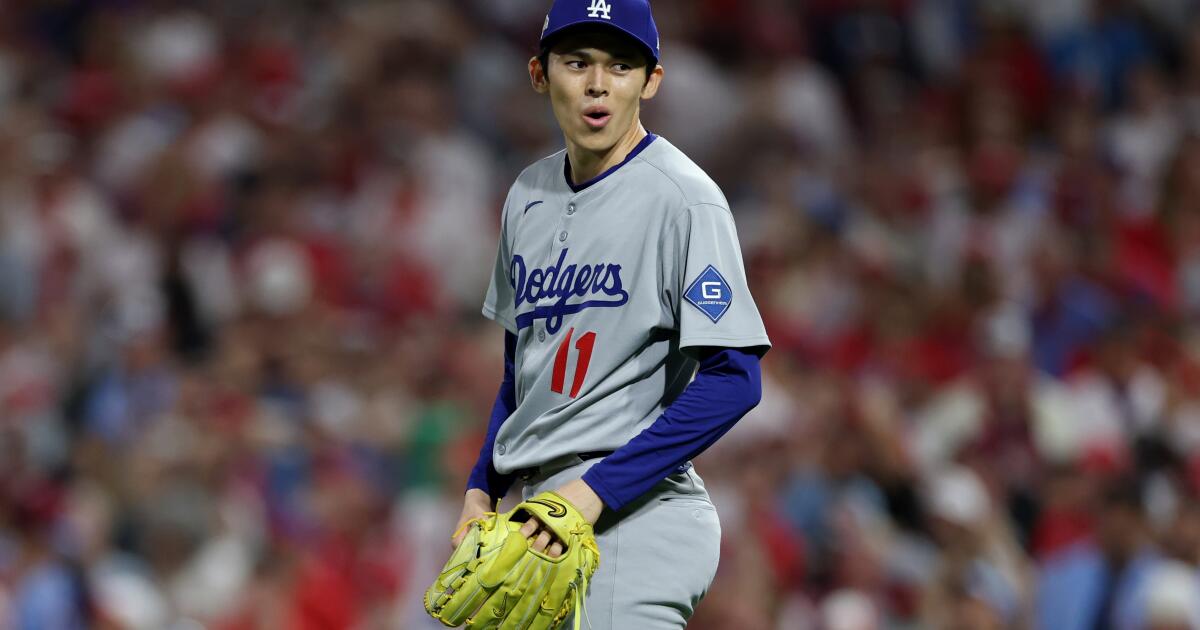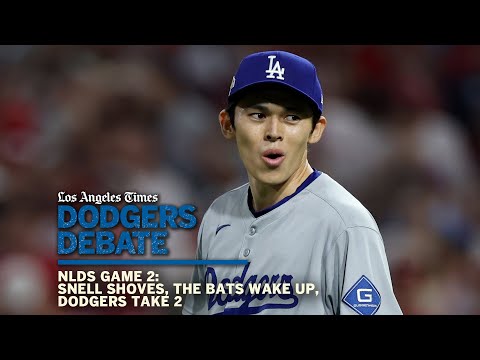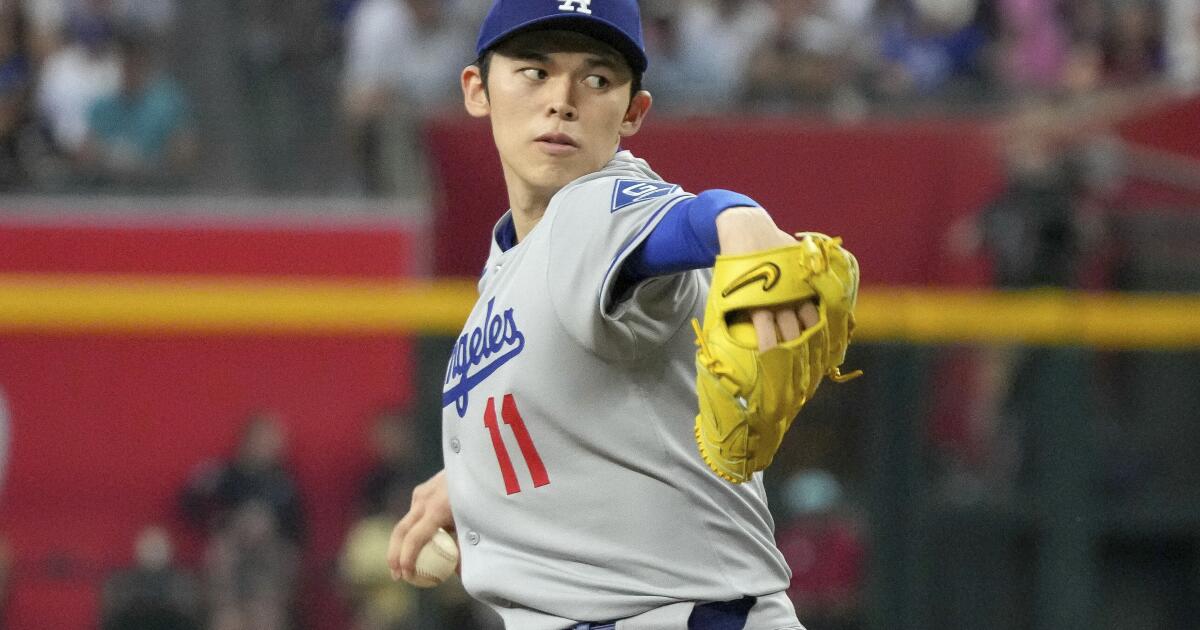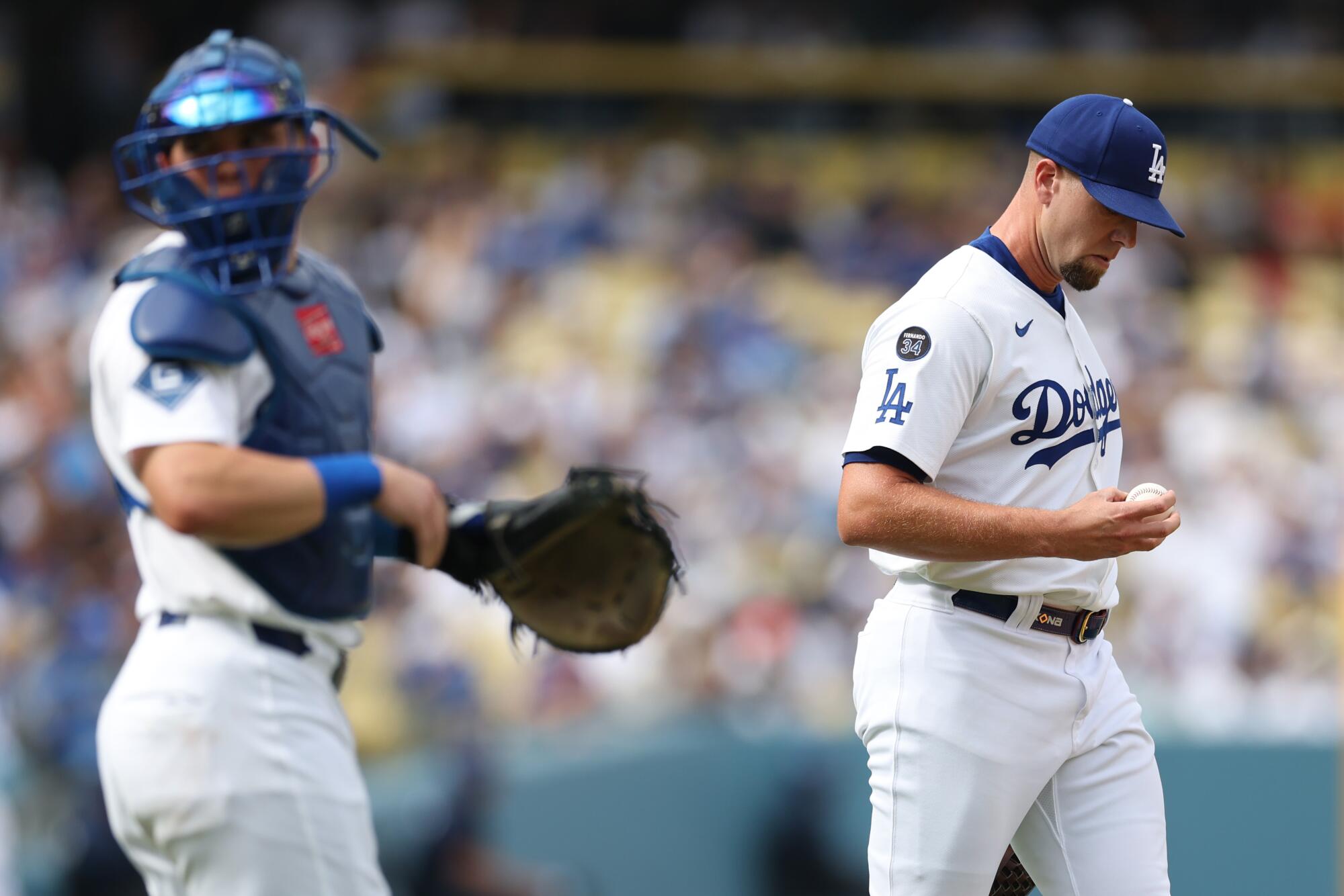From Jack Harris: Dodgers manager Dave Roberts was trying to play the long game Monday night.
Which is why, when his team entered the ninth inning with a three-run lead in Game 2 of the National League Division Series, he gave the save opportunity to Blake Treinen instead of Roki Sasaki.
If all things had been equal, it’s likely that Roberts would have turned to Sasaki to start the inning. In just two weeks since returning from a shoulder injury and being moved to the bullpen, the converted rookie starter has become the club’s most dominant relief option.
But, for as much of a revelation as the 23-year-old right-hander had been in that time — posting four scoreless outings with a 100-mph fastball and unhittable splitter — the team remained conscientious about managing Sasaki’s workload, which included one appearance in Game 2 of the wild card series, then another in Game 1 of the NLDS just days prior.
Thus, with Roberts feeling confident enough in Treinen (the veteran right-hander coming off a career-worst season but also some recently improved outings) to protect a three-run cushion that felt relatively comfortable, he left Sasaki sitting in the bullpen despite the save situation.
Continue reading here
Shaikin: Inside the Mookie Betts play call that won NLDS Game 2 for the Dodgers
Phillies are done, and the Dodgers’ path to the World Series looks clear
MLB POSTSEASON SCHEDULE, RESULTS
NL Division Series
All times Pacific
Dodgers vs. Philadelphia
Dodgers 5, at Philadelphia 3 (box score)
Dodgers 4, at Philadelphia 3 (box score)
Wednesday at Dodgers, 6 p.m., TBS
*Thursday at Dodgers, 3 p.m., TBS
*Saturday at Philadelphia, 5 p.m., TBS
Chicago vs. Milwaukee
at Milwaukee 9, Chicago 3 (box score)
at Milwaukee 7, Chicago 3 (box score)
Wednesday at Chicago, 2 p.m., TBS
*Thursday at Chicago, 6 p.m., TBS
*Saturday at Milwaukee, 1:30 p.m., TBS
AL Division Series
Detroit vs. Seattle
Detroit 3, at Seattle 2 (11) (box score)
at Seattle 3, Detroit 2 (box score)
Seattle 8, at Detroit 4 (box score)
Wednesday at Detroit, noon, FS1
*Friday at Seattle, 1:40 p.m., FS1
New York vs. Toronto
at Toronto 10, New York 1 (box score)
at Toronto 13, New York 7 (box score)
at New York 9, Toronto 6 (box score)
Wednesday at New York, 4 p.m., FS1
*Friday at Toronto, 5 p.m., Fox
*-if necessary
LAKERS
From Broderick Turner: The Lakers’ first practice of the week gave them hope of what they can look like whole when Marcus Smart takes the court.
Smart has been dealing with Achilles tendinopathy most of training camp and has been limited in practice. But coach JJ Redick said after practice Tuesday that Smart “did most of practice, including some live play.”
Redick said LeBron James and Luka Doncic — along with Maxi Kleber (quad) and Gabe Vincent — did “modified, mostly individual work.”
Continue reading here
CHARGERS
From Sam Farmer: The Chargers struck a deal Tuesday to acquire Baltimore Ravens outside linebacker Odafe Oweh in exchange for safety Alohi Gilman.
The Chargers, who play at Miami on Sunday and are looking to stop a two-game slide, are getting a pass rusher who had a career-high 10 sacks last season but had yet to collect one in Baltimore’s 1-4 start this season. Oweh was a first-round pick in 2021.
The Ravens, who host the Rams on Sunday, are in need of secondary help with safety Kyle Hamilton recovering from a groin injury that sidelined him last Sunday against Houston. It’s unclear if he will be ready to play against the Rams.
Continue reading here
From Ben Bolch: One glorious afternoon at the Rose Bowl isn’t enough.
That’s why after they fielded the congratulatory phone calls and text messages, made a celebratory champagne toast and smiled while rewatching game footage for the first time this season, UCLA players and coaches eagerly resumed the pursuit of something more.
“We don’t want to be one-hit wonders,” interim coach Tim Skipper said Monday, “that’s the whole key to this thing — do not be a one-hit wonder, get back to work.”
While beating Michigan State on Saturday at Spartan Stadium wouldn’t generate the same recognition that came with the previously winless Bruins’ recent victory over then-No. 7 Penn State, it would erase any lingering doubts that things just fell into place one wonderful weekend.
Continue reading here
KINGS
From Kevin Baxter: For Kings’ captain Anze Kopitar, Tuesday’s NHL season-opener was the beginning of the end while for Ken Holland, the team’s first-year general manager, it was the end of the beginning.
For both it was also a night to forget, with the Colorado Avalanche skating through, over and around the Kings in a dominant 4-1 victory built on second-period goals from Martin Necas, Sam Malinski, Artturi Lehkonen and a second Necas score midway through the third.
Kevin Fiala got the Kings only score on the team’s third power play of the final period, though the goal, coming with less than five minutes to play, was little more than a murmur of protest. Kopitar picked up his 839th career assist on the play, padding his franchise record and extending his point streak on opening day to eight games.
“That’s a pretty good team,” Kings coach Jim Hiller said afterward. “They did a good job. They out-checked us, they caught us, they disrupted plays, they didn’t let us forecheck.
Continue reading here
Kings summary
NHL standings
THIS DAY IN SPORTS HISTORY
1933 — Cliff Battles of the Boston Redskins becomes the first NFL player to gain more than 200 yards rushing with 215 yards in a 21-20 win over the New York Giants.
1949 — Walt Pastuszak has five of Brown’s 11 interceptions in a 46-0 rout of Rhode Island.
1950 — Bill Grimes of the Green Bay Packers gains 167 yards on 10 carries in a 44-31 loss to the New York Yankees.
1966 — Jerry DePoyster of Wyoming becomes the first player in college football to make three field goals of 50 yards or more in a game. DePoyster connects on two 54-yard tries and a 52-yarder in the Cowboys’ 40-7 rout of Utah.
1961 — Paul Hornung scores 33 points, with four touchdowns, six extra points and a field goal, to lead the Green Bay Packers to a 45-7 romp over the Baltimore Colts.
1977 — No. 7 Alabama beats No. 1 USC 21-20 in Los Angeles. USC fullback Lynn Cain scores with 38 seconds remaining but the 2-point attempt fails.
1992 — Doug Smail scores two goals and the expansion Ottawa Senators rock the Montreal Canadiens 5-3 — the first regular-season NHL game by an Ottawa franchise in 58 years.
1993 — The Anaheim Mighty Ducks, before 17,174 at the Arrowhead Pond, lose 7-2 to the Detroit Red Wings in their first NHL game.
1995 — Dan Marino breaks Fran Tarkenton’s NFL career completions record.
1997 — Adam Oates reaches 1,000 points with three goals and two assists as the Washington Capitals post a 6-3 victory over the New York Islanders.
2005 — Baylor wins a Big 12 road game for the first time in the league’s 10-year history, beating Iowa State 23-13. The Bears had been 0-37 on the road in the Big 12 Conference.
2006 — Randy Moss’ 22-yard TD catch between two defenders 51 seconds before halftime is the Oakland receiver’s 100th touchdown reception. He’s becomes the seventh receiver in NFL history with 100 TD catches.
2011 — Howard scores all its points in the fourth quarter, including 16 in the final 1:27 to beat 29-28 Florida A&M. Parker Munoz caps the improbable comeback by hitting a 21-yard field goal with 4 seconds left following FAMU’s Damien Fleming fumble on the 28-yard line.
2015 — Tampa Bay’s Jason Garrison scores his second goal of the game at 2:17 of the extra period to lead the Lightning past the Philadelphia Flyers in the first 3-on-3 overtime game in NHL history.
2016 — Will Worth and Navy stuns No. 6 Houston, romping to a 46-40 victory. Worth runs for 115 yards and throws two scoring passes for the Midshipmen. Navy hadn’t beaten a top 10 team since 1984, when it topped then-No. 2 South Carolina in Annapolis.
2017 — Aaron Rodgers throws a 12-yard touchdown pass to Davante Adams with 11 seconds remaining, lifting Green Bay over the Dallas Cowboys 35-31 in another thriller nine months after the Packers’ divisional playoff victory on the same field.
2018 — Drew Brees’ 62-yard touchdown pass to rookie Tre’Quan Smith makes him the NFL’s all-time leader in yards passing and sends the New Orleans Saints well on their way to a 43-19 victory over the Washington Redskins. Brees enters the game needing 201 yards to eclipse Peyton Manning’s previous mark of 71,940 yards. He finishes 26 of 29 for 363 yards and three touchdowns.
THIS DAY IN BASEBALL HISTORY
1956 — Don Larsen of the New York Yankees pitches the only perfect game in World Series history, a 2-0 triumph over Brooklyn.
2018 — Red Sox utility player Brock Holt becomes the first MLB player to hit for the cycle in a postseason game.
Compiled by the Associated Press
Until next time…
That concludes today’s newsletter. If you have any feedback, ideas for improvement or things you’d like to see, email me at [email protected]. To get this newsletter in your inbox, click here.















